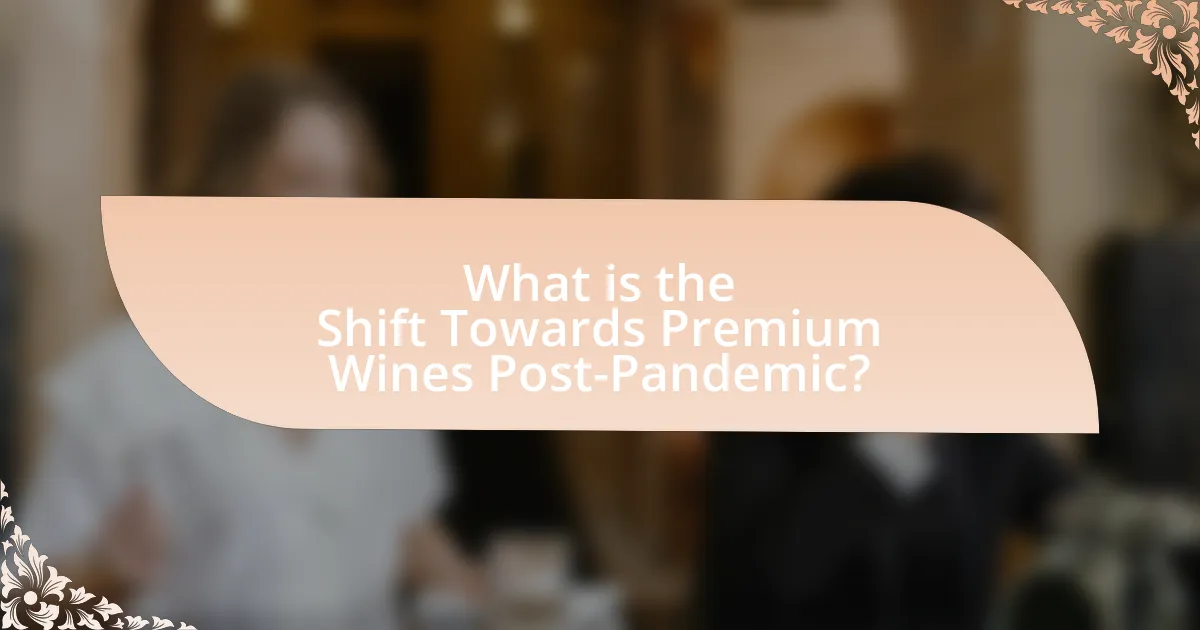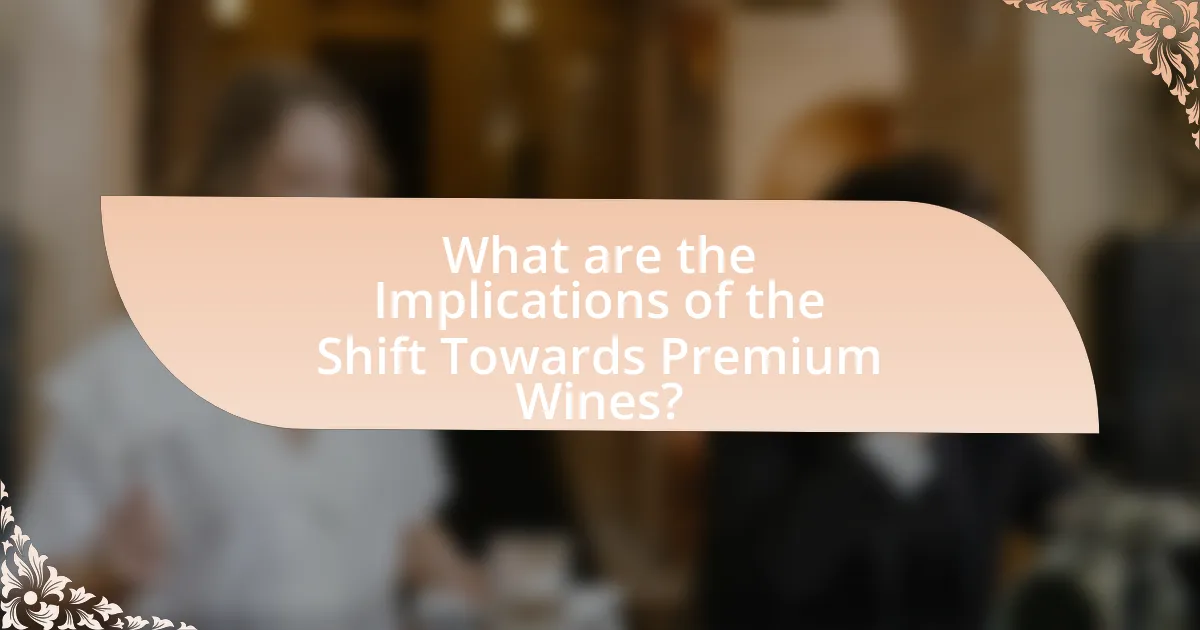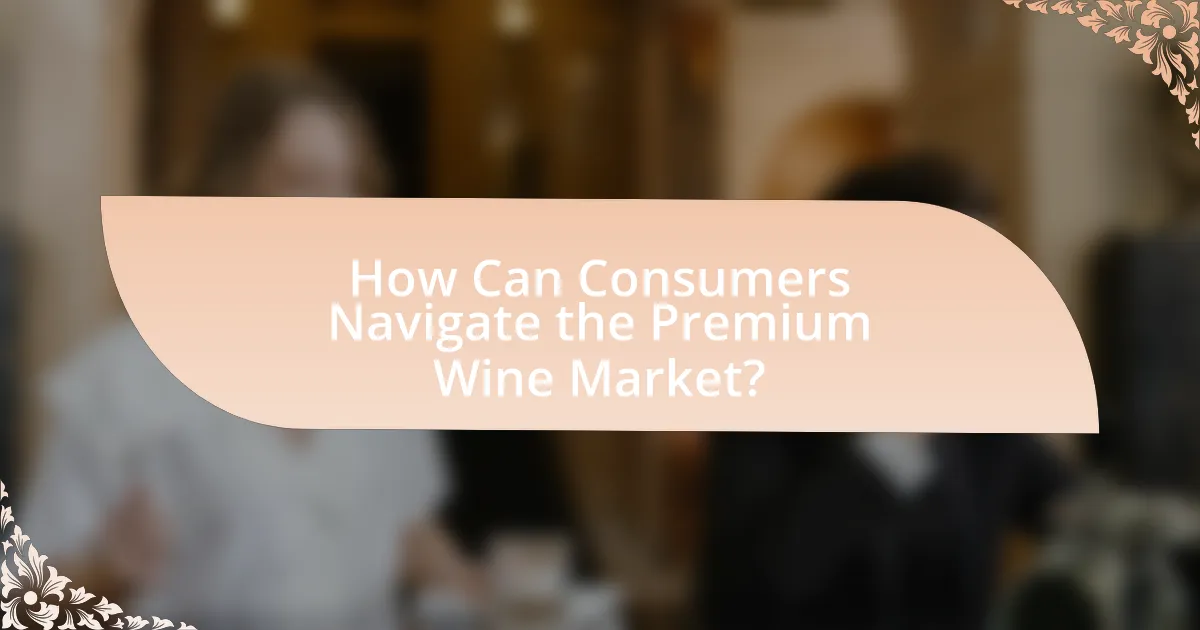The article examines the significant shift towards premium wines following the pandemic, highlighting a growing consumer preference for higher-quality and more expensive options. It discusses how changes in consumer behavior, increased disposable income, and the rise of online sales have contributed to this trend, with premium wine sales experiencing notable growth. Key factors influencing demand include a focus on quality, sustainability, and unique experiences, while economic conditions also play a crucial role in purchasing decisions. The article further explores emerging trends in the premium wine market, regional growth, and the adaptations wineries are making to meet evolving consumer demands. Additionally, it provides insights into how consumers can navigate the premium wine landscape effectively.

What is the Shift Towards Premium Wines Post-Pandemic?
The shift towards premium wines post-pandemic is characterized by an increased consumer preference for higher-quality, more expensive wines. This trend has emerged as consumers, having experienced significant lifestyle changes during the pandemic, are now willing to invest in premium products that enhance their home dining experiences. According to a report by IWSR Drinks Market Analysis, the global premium wine market is projected to grow by 10% annually, reflecting a growing demand for quality over quantity. This shift is also supported by data indicating that consumers are prioritizing experiences and indulgence, leading to a notable rise in sales of premium and super-premium wine segments.
How has consumer behavior changed regarding wine preferences?
Consumer behavior regarding wine preferences has shifted significantly towards premium wines post-pandemic. This change is driven by increased consumer interest in quality over quantity, with many individuals opting for higher-priced, artisanal wines that offer unique flavors and experiences. According to a report by IWSR Drinks Market Analysis, the global market for premium wine has grown by 20% since 2020, indicating a clear trend towards consumers prioritizing premium selections. Additionally, the pandemic has led to more home consumption, prompting consumers to invest in better quality wines for personal enjoyment and special occasions.
What factors have influenced the demand for premium wines?
The demand for premium wines has been influenced by several key factors, including changing consumer preferences, increased disposable income, and the rise of online wine sales. Consumers have shifted towards premium wines due to a growing interest in quality and unique experiences, with a 2021 report from IWSR indicating that the premium wine segment grew by 8% in volume globally. Additionally, as disposable incomes have risen, particularly in emerging markets, consumers are more willing to spend on higher-quality products. The COVID-19 pandemic accelerated the trend of online shopping, with e-commerce sales of wine increasing by 234% in 2020, making premium wines more accessible to a broader audience.
How do economic conditions affect wine purchasing decisions?
Economic conditions significantly influence wine purchasing decisions by affecting consumer disposable income and spending behavior. During economic downturns, consumers tend to prioritize essential goods over luxury items, leading to decreased wine sales, particularly in the premium segment. For instance, a study by the IWSR Drinks Market Analysis indicated that during the 2008 financial crisis, wine consumption dropped as consumers opted for lower-priced alternatives. Conversely, in times of economic growth, consumers are more likely to indulge in premium wines, as evidenced by the post-pandemic surge in sales of high-end wines, which increased by 20% in 2021 according to Nielsen data. This trend illustrates that favorable economic conditions can lead to a shift towards premium wine purchases, reflecting consumers’ willingness to spend more on luxury items when their financial situation improves.
Why are consumers gravitating towards premium wines?
Consumers are gravitating towards premium wines due to a heightened appreciation for quality and unique experiences. This shift is largely influenced by the pandemic, which led individuals to seek comfort and indulgence in higher-quality products. According to a report by IWSR Drinks Market Analysis, premium wine sales increased by 20% in 2021, indicating a significant trend towards more expensive and higher-quality options. Additionally, consumers are increasingly valuing sustainability and artisanal production methods, which are often associated with premium wine brands. This combination of factors has resulted in a marked increase in demand for premium wines.
What role does quality play in consumer choices?
Quality significantly influences consumer choices by serving as a key determinant in the selection of products, particularly in premium markets like wines. Consumers often associate higher quality with better taste, reliability, and overall satisfaction, leading them to prefer premium options over lower-quality alternatives. Research indicates that 70% of consumers are willing to pay more for products they perceive as higher quality, demonstrating the direct impact of quality on purchasing decisions. This trend is particularly evident in the post-pandemic wine market, where consumers have shifted towards premium wines, seeking enhanced experiences and value in their purchases.
How has the pandemic altered perceptions of luxury in wine?
The pandemic has shifted perceptions of luxury in wine by elevating the importance of quality and experience over mere status. Consumers increasingly prioritize premium wines that offer unique flavors and artisanal production methods, reflecting a desire for authenticity and personal connection. This trend is supported by data indicating a significant increase in sales of high-end wines, with a 20% rise in the premium wine segment during 2020, as reported by the IWSR Drinks Market Analysis. The pandemic has thus transformed luxury wine from a symbol of wealth to a representation of personal enjoyment and meaningful experiences.
What trends are emerging in the premium wine market?
Emerging trends in the premium wine market include a significant increase in online sales, a growing preference for sustainable and organic wines, and a rise in interest for unique varietals and regions. The shift to online purchasing has been accelerated by the pandemic, with e-commerce sales of wine increasing by 234% in 2020, according to a report by IWSR. Additionally, consumers are increasingly prioritizing sustainability, with 60% of wine drinkers expressing a preference for organic or biodynamic wines, as highlighted in a survey by Wine Intelligence. Furthermore, there is a notable trend towards exploring lesser-known wine regions and varietals, driven by consumers’ desire for unique experiences and flavors, as evidenced by the growing popularity of wines from regions like Portugal and Greece.
Which regions are seeing growth in premium wine sales?
Regions experiencing growth in premium wine sales include North America, particularly the United States, and parts of Europe, notably France and Italy. The U.S. has seen a significant increase in demand for high-quality wines, with a reported 20% rise in premium wine sales from 2020 to 2022. In Europe, France and Italy have also reported a resurgence in premium wine consumption, driven by a shift in consumer preferences towards higher-quality products post-pandemic. This trend is supported by market research indicating that consumers are willing to spend more on premium wines as they seek enhanced experiences and quality.
How are wineries adapting to meet changing consumer demands?
Wineries are adapting to meet changing consumer demands by focusing on premium wine offerings and enhancing direct-to-consumer sales channels. This shift is driven by a growing consumer preference for high-quality, unique wines, which has been evidenced by a 2021 report from the IWSR that indicated a 20% increase in premium wine sales during the pandemic. Additionally, wineries are investing in digital marketing strategies and e-commerce platforms to reach consumers directly, reflecting a trend where 60% of wine consumers prefer purchasing online. These adaptations not only cater to evolving tastes but also align with the increased demand for personalized experiences in wine consumption.

What are the Implications of the Shift Towards Premium Wines?
The shift towards premium wines implies a significant change in consumer preferences, leading to increased demand for higher-quality products. This trend is driven by consumers’ willingness to invest in better experiences and the perception of premium wines as a status symbol. According to a report by IWSR Drinks Market Analysis, the premium wine segment has seen a growth rate of 6% annually, indicating a robust market shift. Additionally, this shift affects production practices, as wineries may focus more on sustainable and organic methods to meet the expectations of discerning consumers.
How does this shift impact the wine industry as a whole?
The shift towards premium wines post-pandemic significantly enhances the wine industry’s profitability and market dynamics. This trend indicates a growing consumer preference for higher-quality products, leading to increased sales and higher price points for premium wines. According to a report by IWSR Drinks Market Analysis, the premium wine segment has seen a compound annual growth rate of 6% from 2020 to 2023, reflecting a robust demand for luxury wine experiences. This shift not only boosts revenue for producers but also encourages wineries to invest in quality and innovation, ultimately elevating the overall standard of wine production.
What changes are being observed in wine production practices?
Changes in wine production practices include a shift towards sustainable and organic farming methods, increased use of technology for precision viticulture, and a focus on lower yields to enhance quality. Sustainable practices are being adopted as consumers demand environmentally friendly products, with organic vineyard acreage in the U.S. growing by 20% from 2019 to 2021. Additionally, technology such as drones and soil sensors is being utilized to monitor vineyard conditions more accurately, leading to better resource management. Lower yields are being prioritized to improve the concentration and complexity of flavors in wines, aligning with the trend towards premium wine production post-pandemic.
How are marketing strategies evolving in response to consumer trends?
Marketing strategies are evolving to prioritize personalization and digital engagement in response to consumer trends. As consumers increasingly seek tailored experiences, brands are leveraging data analytics to understand preferences and behaviors, allowing for targeted marketing campaigns. For instance, a report by McKinsey highlights that 71% of consumers expect companies to deliver personalized interactions, prompting businesses to adopt advanced segmentation and customer relationship management tools. Additionally, the rise of social media and e-commerce has led brands to enhance their online presence, utilizing platforms like Instagram and TikTok to connect with consumers through engaging content and influencer partnerships. This shift reflects a broader trend towards authenticity and transparency, as consumers favor brands that align with their values and lifestyle choices.
What challenges do wineries face in this new landscape?
Wineries face several challenges in the new landscape shaped by the shift towards premium wines post-pandemic. These challenges include increased competition from both established and emerging wine regions, which has intensified the need for differentiation in product offerings. Additionally, wineries must navigate changing consumer preferences that favor premium products, requiring them to adapt their marketing strategies and production processes to meet these demands. Economic factors, such as inflation and supply chain disruptions, further complicate operations, impacting costs and availability of raw materials. According to a report by the Wine Market Council, premium wine sales have surged, but wineries must also contend with the need for sustainable practices to appeal to environmentally conscious consumers.
How can wineries maintain quality while scaling production?
Wineries can maintain quality while scaling production by implementing strict quality control measures and investing in technology. Quality control protocols, such as regular testing of grapes and wine at various stages, ensure that standards are upheld even as production increases. Additionally, technology like precision viticulture and automated monitoring systems can enhance consistency and reduce human error. For instance, a study by the University of California, Davis, highlights that wineries utilizing advanced analytics can improve grape selection and fermentation processes, leading to higher quality outputs. This combination of rigorous quality assurance and technological investment allows wineries to scale effectively without compromising on the premium quality of their wines.
What are the risks associated with focusing on premium wines?
Focusing on premium wines carries several risks, including market volatility, limited consumer base, and higher production costs. Market volatility can lead to significant fluctuations in demand, as premium wines are often more sensitive to economic downturns, resulting in potential revenue loss. The limited consumer base for premium wines restricts sales opportunities, as only a segment of consumers can afford or choose to purchase these products, which can lead to over-reliance on a niche market. Additionally, higher production costs associated with premium wine production, such as sourcing quality grapes and maintaining strict quality control, can impact profitability, especially if sales do not meet expectations. These factors collectively pose substantial risks for businesses that concentrate their efforts on premium wines.

How Can Consumers Navigate the Premium Wine Market?
Consumers can navigate the premium wine market by educating themselves on wine regions, varietals, and tasting notes to make informed purchasing decisions. Understanding the characteristics of different wine regions, such as Napa Valley for Cabernet Sauvignon or Burgundy for Pinot Noir, helps consumers identify quality wines. Additionally, tasting notes and reviews from reputable sources can guide selections, as they often highlight the nuances of flavor and aroma that distinguish premium wines. According to a 2021 study by the Wine Market Council, 60% of consumers reported increased interest in premium wines post-pandemic, indicating a shift towards quality over quantity. This trend suggests that consumers are willing to invest in higher-priced wines that offer unique experiences, reinforcing the importance of knowledge in navigating this market.
What should consumers consider when choosing premium wines?
Consumers should consider the wine’s origin, varietal, vintage, and producer reputation when choosing premium wines. The origin influences the wine’s characteristics due to climate and soil conditions; for example, wines from Bordeaux are known for their complexity. The varietal determines flavor profiles, with Cabernet Sauvignon offering boldness and Pinot Noir providing elegance. Vintage is crucial as it reflects the growing conditions of that year; for instance, a highly rated vintage can significantly enhance quality. Lastly, the producer’s reputation often correlates with quality, as established wineries typically maintain higher standards. These factors collectively guide consumers in selecting premium wines that align with their preferences and expectations.
How can consumers identify quality in premium wines?
Consumers can identify quality in premium wines by evaluating factors such as the grape variety, region of origin, vintage, and winemaking techniques. High-quality wines often come from renowned regions like Bordeaux or Napa Valley, where specific grape varieties thrive due to optimal climate and soil conditions. Additionally, the vintage year can indicate quality, as certain years yield better grapes due to favorable weather conditions.
Winemaking techniques, such as the use of oak barrels for aging, can enhance flavor complexity and depth, signaling a premium product. Furthermore, consumers can look for certifications or awards from reputable wine competitions, which often reflect the wine’s quality. For instance, wines that receive high scores from critics or organizations like Wine Spectator or Robert Parker are typically recognized for their excellence.
What resources are available for wine education and selection?
Resources available for wine education and selection include online courses, books, wine tasting events, and certification programs. Online platforms like MasterClass and Coursera offer courses taught by industry experts, while books such as “The Wine Bible” by Karen MacNeil provide comprehensive knowledge on wine varieties and regions. Wine tasting events, often hosted by local wineries or wine shops, allow individuals to experience different wines firsthand and learn from sommeliers. Additionally, certification programs like those offered by the Wine & Spirit Education Trust (WSET) provide structured education and recognized qualifications in wine knowledge. These resources collectively enhance understanding and selection of wines, catering to both novices and enthusiasts.
What are some tips for enjoying premium wines?
To enjoy premium wines, focus on proper serving temperature, glassware, and food pairings. Serving premium wines at the correct temperature enhances their flavors; for example, red wines are best served slightly below room temperature, while white wines should be chilled. Using appropriate glassware, such as tulip-shaped glasses, allows for better aeration and aroma concentration, which is essential for appreciating the wine’s complexity. Additionally, pairing premium wines with complementary foods can elevate the tasting experience; for instance, a rich Cabernet Sauvignon pairs well with grilled meats, enhancing both the wine and the dish. These practices are supported by wine experts who emphasize the importance of temperature, glass shape, and food pairing in maximizing the enjoyment of high-quality wines.
How can food pairings enhance the experience of premium wines?
Food pairings enhance the experience of premium wines by complementing and elevating the wine’s flavors, aromas, and textures. When specific foods are matched with premium wines, they can create a harmonious balance that accentuates the wine’s characteristics, such as acidity, tannins, and fruitiness. For example, a rich Cabernet Sauvignon pairs well with a fatty steak, as the wine’s tannins soften the meat’s texture while enhancing its savory flavors. Studies have shown that food and wine interactions can significantly influence taste perception, with research indicating that the right pairings can enhance enjoyment by up to 30%. This synergy not only enriches the tasting experience but also encourages consumers to explore premium wines more deeply, fostering a greater appreciation for their complexity and craftsmanship.
What are the best practices for storing premium wines at home?
The best practices for storing premium wines at home include maintaining a consistent temperature between 50-55°F (10-13°C), ensuring humidity levels around 60-70%, and storing bottles horizontally to keep the cork moist. Consistent temperature is crucial because fluctuations can damage wine, while proper humidity prevents corks from drying out and allows for optimal aging. Additionally, wines should be kept away from direct sunlight and vibrations, as these factors can negatively impact flavor and quality. Research indicates that wine stored under ideal conditions can age gracefully, enhancing its complexity and taste.